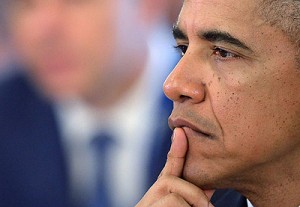Obama fights battle to modernize infrastructure
Sunday, May 18th, 2014 8:10:35 by Khalil Khan
The U.S. president, Barack Obama, I dreamed of a country crossed by high-speed trains, no traffic jams on the highways and bridges in danger of collapse. The legislative gridlock on Capitol Hill and little appetite for spending more taxpayer money would have prevented Obama address one of the priorities of his presidency: the modernization of a network of old infrastructure, whose degradation threatens the status of economic power in the country.
The White House has tried this week reposition infrastructure in the center of the political debate. On the banks of the Hudson River from a bridge connecting New Jersey with New York state, Obama urged Congress to release funds to improve roads, bridges and railways. Not, warned, it may cost the U.S. economy up to 700,000 jobs.
“One of the reasons that America became an economic superpower was the construction of a world class transport system,” said the president.
The transformation of this country in less than two centuries, a confederation of British colonies in America a superpower without the multimillion investment in infrastructure is not understood. Since the railways in the nineteenth century to the highways in the fifties of the twentieth century through the New Deal of Franklin D. Roosevelt or military network that was the embryo of the Internet, I articulated U.S. infrastructure and consolidated their ascent.
The history of the U.S., explains historian Michael Lind, is an unresolved conflict between Hamiltonian and jeffersionianos. The first recalls Lind in an email, follow the tradition of Alexander Hamilton, the first Treasury Secretary favored a strong central state and dedicated to promote industrial and economic development. The latter was inspired by President Thomas Jefferson, suspicious interventionist central government.
“The Hamiltonian projects like the transcontinental railroad in the nineteenth century or in the twentieth interstates tend to succeed during military crises like the Civil War or the Cold War, when the imperative of national security is imposed on localism and hostility of Jeffersonian federal government, “says Lind, author of Land of promise and co-founder of the think tank New America Foundation.
In recent years, the Jeffersonian – identified now with the right-wing populism of the Tea Party movement, have opposed attempts to invest public money in infrastructure. The most recent occurred in 2009, when Congress passed a stimulus plan to be prepared by the USA for the XXI century. These efforts were stopped in 2011, when Republicans became the majority party in the House of Representatives.
Obama stood halfway. An example: the trains of the Spanish company Talgo parked so far in Wisconsin, where the arrival of Republican governor Scott Walker, in 2009, halted plans to bring high speed this Midwestern state.
The stimulus plan allowed improvements. ” It helped a lot: probably improved our situation very bad to just bad,” he says by phone Michael Grunwald, author of The new new deal (The new new deal), a chronicle of the transformative effects of the Obama stimulus plan.
The latest reports published every four years the American Society of Civil Engineers raised the rating of the U.S. infrastructure a D + D, on a scale of A to F. In various rankings of the World Economic Forum competitiveness, Spain exceeds to the USA.
” [ The poor state of infrastructure ] is the result of having been so successful in the previous generation. Most of the improvement of infrastructure in this country occurred in the sixties and seventies, when there was a great economic expansion, “says Randy from Ohio Over, President of the American Society of Civil Engineers.
USA is a modern country, but half a century ago. Any visitor who has lived in Spain during the boom, will collide potholes, high and vulnerable to falling trees and the absence of genuine high-speed rail power lines. Walking on the train ride to New York Washington, 370 miles, it takes longer to travel 600 between Barcelona and Madrid.
” If you are unable to transport goods, can not work,” says Over. ” If the electricity grid does not work properly if the oil can not get from one end to another country for oil, trains or trucks this affects our ability to be an economic power.”
Foreign policy begins at home (‘Foreign policy begins at home’) is the title of the latest book by Richard Haass, president of the think tank Council on Foreign Relations. “America “, Haass complains in the book, ” spends less than 2% of its GDP on infrastructure, while China spends 9% and 8% Indian.
The idea that Obama often mentioned is that before you embark on wars to re- distant countries, as in the past decade, the priority is internal reconstruction. U.S. persistence is also played as a world power.
Short URL: https://www.newspakistan.pk/?p=44148

















